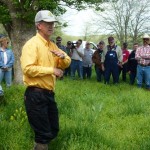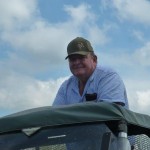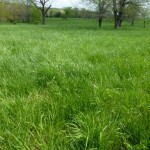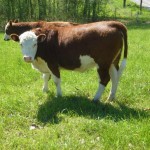Yes, it’s true….
 ….Greg and Jan Judy’s Green Pastures farm certainly lives up to its name. More than 50 would-be grazers attended Greg’s three-day program near Moberly, Missouri last week to study the power of mob grazing.
….Greg and Jan Judy’s Green Pastures farm certainly lives up to its name. More than 50 would-be grazers attended Greg’s three-day program near Moberly, Missouri last week to study the power of mob grazing.
It’s been a cold, wet spring but the proof was there as you drove down the road. Greg’s green pastures alongside neighbors who were still feeding hay!
 The featured speaker was Ian Mitchell-Innes who practices a version of what might be called “Mob Grazing for Dummies”. Ian’s approach is throw you in the shallow water so you don’t have to drown. He has become something of a missionary in the battle to save the microbe. There’s no doubt in Ian’s mind that we can feed the world’s hungry, if we can just get the politicians and experts out of the way.
The featured speaker was Ian Mitchell-Innes who practices a version of what might be called “Mob Grazing for Dummies”. Ian’s approach is throw you in the shallow water so you don’t have to drown. He has become something of a missionary in the battle to save the microbe. There’s no doubt in Ian’s mind that we can feed the world’s hungry, if we can just get the politicians and experts out of the way.
We like to think we have pretty good grass at Thistle Hill but 
Greg’s fields clearly win first prize. While he generally puts a lot of pressure on the ground, the secret is to move the herd quickly. And his stocking rate is very conservative with plenty to spare for emergencies.
And the proof of course is in the eating….what the cows eat. The se young heifers have certainly come out of the winter….and it was a brutal one….none the worse for wear. Greg’s cows are South Poll, an animal developed in Alabama by country musician Teddy Gentry, who has become a leading expert on the production of grass fed beef. We have Senepol cows from Teddy’s farm at Thistle Hill, one of the four breeds which make up the South Poll cross.
se young heifers have certainly come out of the winter….and it was a brutal one….none the worse for wear. Greg’s cows are South Poll, an animal developed in Alabama by country musician Teddy Gentry, who has become a leading expert on the production of grass fed beef. We have Senepol cows from Teddy’s farm at Thistle Hill, one of the four breeds which make up the South Poll cross.
We use our Devon bulls on them and like the result very much.
11 Comments
mike ortwein
As I see it there are two schools of thought on grazing livestock: the most prevalent is feeding the animal (jim Gerrish) or feeding the soil (Greg Judy). Greg feeds the soil, which feeds the grass, which feeds the animal. That is why it is important to let your pastures go to a seed head before you graze them: they eat a third, leave a third and trample a third, and in so doing feed the soil. Gerrsih buys fertilizer, Judy does not, I rest my case–Mike Ortwein
Jim Gerrish
Mike, What is the case that you are resting?
mike ortwein
Judy is more sustainable, requires less outside inputs. Cody Holmes only buys salt, not sure about Greg on other outside purchases. I just buy minerals and seed when we clear for more pasture.
Jim Gerrish
What does sustainability mean? Do you consider return on assets? Net return per acre? Or do you just assume if someone doesn’t buy fertilizer it automatically means their operation is more sustainable than another? Is buying hay as a nutrient source more sustainable than buying fertilizer? Why? What is the relative expenditure for soil amendments per lb of beef or lamb produced between two operations with one using purchased hay as a source of nutrients and one buying fertilizer? What is the difference in gross margin? What do you mean when you say ‘buying fertilizer’? Are you talking about routine use of N fertilizer or investment in lime, P, S, and B? Have you ever done a cost:benefit analysis of using lime vs. doing nothing?
mike ortwein
To me, sustainability means not having to go off my property to purchase a finite resource. Looking at return on assets, to do a proper financial analysis we would have to use a discounted cash flow calculation. The critical factor here is what do we select for a discount rate: the abnormally low interest rate encouraged by the Federal Reserve system which has caused tremendous amount of malinvestment in our economy and out of control spending by the federal government (not sustainable long haul). If you do not have to purchase fertilizer you are more sustainable because through your grazing methods you are maintaining and improving the productivity of your soil by encouraging biological life, whereas most chemicals destroy it. I would agree that purchasing hay is a way to bring more nutriients onto your property but a better way to “kick the hay habit” altogether but without importing N – rather by using grazing management.
When you source inputs from outside your property you are at the mercy of price fluctuation, availability, delivery expense and the timeliness of the delivery – all of which you have no control over. The market economy is the most efficient and just economy in the world but it is dependent on: a sound and stable currency (the US dollar has lost 95% of its purchasing power since the Fed was established and the Fed has now taken the monetary base from $800 Billion to $3.2 Trillion in the last 5 years – currently expanding it at 16.3% annually), respect for property rights (better not have a wetland on your property) and the rule of law (what have you done to make the IRS happy today?).So to me being sustainable is being able to deliver quality, healthy beef with minimum dependency on the outside world. Agriculture in this country is totally dependent on the petrochemical industry and Monsanto. It is a time bomb waiting to go off. Our soils are dead, our food has lost much of its nutrient value and our soil is winding up in New Orleans. Add to that 50% of the population is dependent on the government to steal or borrow from others to keep them alive and the best ROI is to be food self sufficient and sustainable. Personally I recommend a person have a 1/2 acre well stocked pond that is at least 12 ft. deep, that is sustainable if the watershed is not laced with chemical residues from the local farmers.
Jim Gerrish
Mike, While you made a nice lengthy post, you really didn’t address the questions that I raised. A few additional comments.
All of the cost:benefit analysis I do is based on future value and also accounts for an ongoing return on investment above and beyond break even in a NFV sense. You must also consider the potential future revenue stream which requires projection of product value in to the future.
When you said “Gerrish buys fertilizer, Judy does not”, I still don’t know what exactly what you are saying. I asked if you were specifically referring to N fertilizer or also to lime, P, K, S, B etc. Which is it? BTW., in both ‘No-risk Ranching’ and ‘Comeback Farms’, Greg indicates they (or the landowners they lease from) applied lime and the land benefited from that application. Do you not consider that fertilization? It is ironic that Greg entitles his fertility chapter in ‘Comeback Farms’ as “Our free fertility program – Using hay to add nutrients” and the first words in the chapter are “Purchased hay….”. How the hell is that free?
There was never a situation where I ‘had to’ buy fertilizer to maintain our operation. There were times I chose to do so because it provided an acceptably high rate of return on my investment. I could have chosen to accept a particular level of productivity or rate of increase. I chose to accelerate the process because it was more profitable to take that avenue. An example. Most of the farm we had in Missouri was derelict cropland that had been severely eroded. The soil pH ranged from 4.3 to 5.3 and in most cases the available soil P was less than 3 ppm. On most of the land, we limed, added P, and seeded a grass-legume mix to accelerate the rate of plant establishment and soil improvement. There was one area I chose not to make those amendments so we could see what happened if all we did was manage the grazing on those areas. I let that experiment go on for ten years. At the end of ten years time, the test area had improved to finally reach 100 stock-days/acre. (SDA) harvested annually. Meanwhile, the ‘improved’ areas were at 180-190 SDA and had been producing at that level for most of the ten years. Over the course of the ten years, the improved areas yielded just over 1300 more total SDA than the test area. If we use a very conservative net value of 25 cents/SDA (Today in many of our analyses we are using a net of 80-90 cents/SDA), we earned an additional net income of $325/acre. Using an 8% discount rate, based on our per acre investment at the time, the future value of that investment was projected to be $131. We achieved $325. That is a pretty good return on investment. This is why I say it is naïve to claim one production system is more sustainable than another simply because of a difference in fertilizer use at some point in time.
I don’t understand this statement at all, what do you mean? “I would agree that purchasing hay is a way to bring more nutriients onto your property but a better way to “kick the hay habit” altogether but without importing N – rather by using grazing management.”
I pretty well agree with everything in your second paragraph. I would add to it though, that if you wish to add to your nutrient pool on your farm or ranch, you should do it at a time when the basic business factors allow it to a occur with a very positive financial response.
mike ortwein
This has been fun!
Edward Taylor
I live in central Vermont. Though I am sure it is possible in principle it is extremely difficult in practice to pasture throughout the winter. It is a risky proposition year to year to depend on one’s ability to pasture year around.
Gerrish lives in Idaho and Judy lives in Missouri. There must be many variables in play- soils, climates, markets, etc-that can lead to different management styles, if indeed their management styles are different. And I don’t know why- a priori- feeding hay out is bad for soil health if it is fed where it was harvested.
The hallmark of good management- in any endeavor- is a kind of practical and adaptive flexibility that recognizes one’s circumstances and acts accordingly.
Jim Gerrish
Edward, There is nothing at all wrong with feeding hay for soil health. My only point is know what it is costing you and what are the alternatives. Making hay is usually far more costly to the livestock producer than buying someone else’s hay and feeding that on your place. Many people assume one practice or another is too costly or another practice always pays, but few have ever actually done a cost:benefit analysis to determine whether or not one practice is more beneficial than another.
Edward Taylor
Yes I see your point on the importance of attempting to quantifying one’s beliefs and I completely agree (especially given my day job- I work in math.)
The hay business was a digression on my part in which I (rather poorly) attempted to make a point that there are a lot of variables to consider. I’m suspicious of pronouncements (e.g. it is always bad to fertilize) without attempting to put the pronouncement in the context of local conditions.
Thanks again for your reply.
Forrest
Having read this I believed it was rather informative. I appreciate you taking the
time and energy to put this short article together.
I once again find myself spending a lot of time both reading and leaving
comments. But so what, it was still worth it!